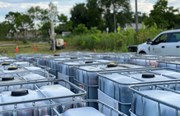4 Common Questions About ISTR Treatments at Petroleum Impacted Sites
By: Cascade EnvironmentalWhen TerraTherm, a Cascade Company experts present at a conference or a webinar, it doesn’t matter how much material they cover—there are always questions. After presenting a webinar on January 23, titled ISTR Applications at Petroleum Impacted Sites, Technical Director Rob D’Anjou received several that are fairly common. In this blog post, he shares those questions and the answers you may also be looking for.
If you are attending the International In-Situ Thermal Treatment Symposium (I2T2) this week, you can ask Rob questions as well at his presentation on Friday titled, “Electrical Resistance Heating and Bioremediation: Compatibility, Effectiveness, and Post-Heating Bio-Polishing,” or at his poster session, “ISTR Applications at Petroleum Impacted Sites.” You can also meet two of our other experts, Steffen Griepke Nielsen, at his Friday presentation, “When Mass NAPL Removal Governs the Clean-Up,” and John LaChance at his presentation, “A Multiple Lines of Evidence Approach For Determining When to Shut Down an In Situ Thermal Remediation System” on Thursday.
Is it feasible to use in situ thermal remediation (ISTR) remedies on a more remote site such as national park land where a spill occurred?
Yes. One of the logistical challenges is the power needed. Steam enhanced extraction (SEE) is the easiest to implement at remote locations because it doesn’t need a huge power drop, and the boiler units can be powered by fossil fuels rather than needing a large source of electrical power. We can and we have done sites where it wasn’t possible to get enough power from the existing power grid, so we used diesel generators to provide a power supply. That can incur higher project cost, but it is definitely not out of the question.
Can ISTR technologies be constructed below ground? For example, below an active roadway and intersection.
Implementing ISTR projects at active sites, where you need to limit impact to the access of the facility, is something that we regularly encounter and have developed robust engineering controls to mitigate any impacts to project efficacy and the health and safety of people in the active areas. We implemented all of these technologies below ground, below the floor slab of active buildings or below the roadway and public rights of way such as sidewalks. We have plenty of engineering controls to mitigate impacts and ensure safety. For electrical resistance heating (ERH), these include isolation transformers and adequate vapor extraction systems. These can all be installed below grade, trenched out for conveyance where you can pave over the sidewalk or roadway. We have also implemented these below active office buildings—unless someone already knows what’s going on, there really would be no reason for anyone to be the wiser. With active gas station sites, we can put engineering controls in place to protect subsurface utilities using enhanced subsurface vapor extraction around utility lines to draw heat away and minimize steam impacts. We also install temperature monitoring points to ensure we aren’t overheating anything, and in regard to ERH, to ensure there is no stray voltage being fluxed onto subsurface piping or tanks.
If we have a site for which we are considering thermal treatment, do you have a model that you can run to help design heater well spacing, time for heating, etc. in both the vadose and saturated zones?
Absolutely. Over the past few decades, as an industry, we’ve developed some pretty advanced modeling calculations and algorithms that look at optimal spacing of wells, heat balance, the specific contaminant species, overall removal efficacies at varying temperatures, etc. Our calculations and algorithms run nearly every consideration you can imagine. We’ve gotten very accurate at that. Even for preliminary costing, we have models we run every time which come up with a quick preliminary for a client that includes energy consumption, well spacing, design considerations and overall project costs.
Can you effectively treat PFAS/compounds with thermal?
PFAS/PFOA compounds are a high priority emerging contaminant, pervasive around the world, and their physio-chemical characteristics make them incredibly difficult compounds to remediate with in situ technologies. PFAS are synthetically produced chemicals, with a marked resistance to heat, water, and oil and are very highly water soluble. The most prominent PFAS include perfluorooctane sulfonate(PFOS) and perfluorooctanoic acid (PFOA). PFAS are increasingly detected in soils, surface, and drinking water.
Some of what makes these contaminants of particular concern and interest is their persistence in the subsurface and their ability to easily and effectively transport long distances in the aqueous phase, often leading to extended groundwater plumes and long range impacts.
Resistance to natural attenuation processes in groundwater bolsters those concerns, further permitting long-distance migration in plumes. Because of this, demand for PFAS testing, analysis and effective remedial strategies has increased exponentially over the past few years, and continues to do so.
The complexity of in situ remedial design and strategy is not lost in a thermal application. These compounds can effectively be remediated using a Thermal Conduction Heating (TCH) high temperature thermal desorption application (ie, over 350⁰C), at which temperatures PFAS/PFOA contamination is quickly volatilized and removed from the soil/groundwater in a matter of days. The complicating factor is, however, the highly water soluble nature of these compounds. For a high temperature in situ thermal treatment strategy to be successful, the treatment volume needs to be dried out, and the water table depressed. This would preferentially keep these contaminant species in the dissolved phase, leaving little PFOS/PFOA mass sorbed to the soil matrix and effectively remediated within the treatment volume. However, in-pile thermal desorption (IPTD) for stock piled sub-surface materials, and ex situ thermal remediation (HB1100) strategy do present incredibly effective options for ex situ thermal remediation of PFAS/PFOA compounds, capable of reaching non-detect concentrations.
You can also watch this webinar for more information about ISTR options.

